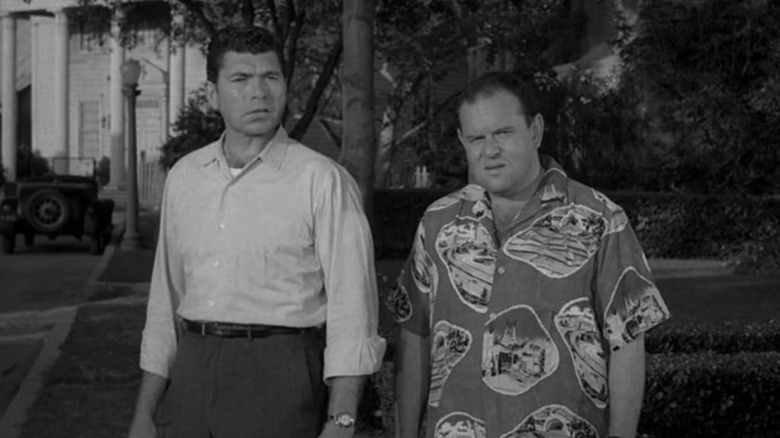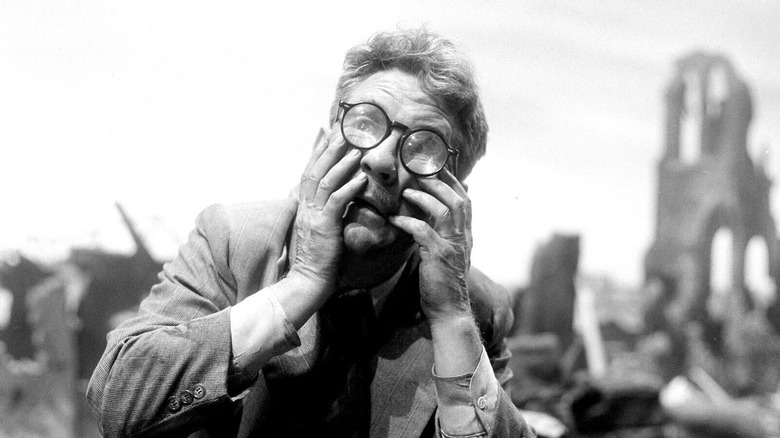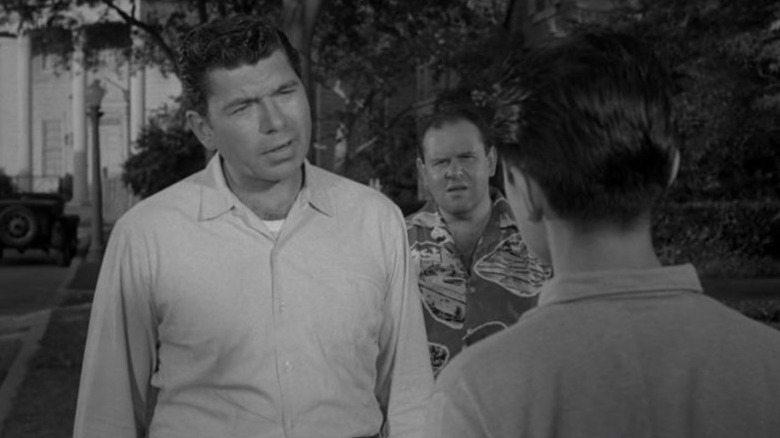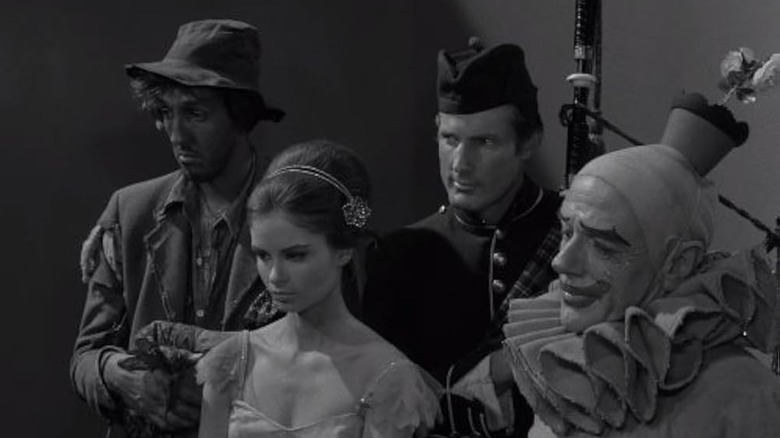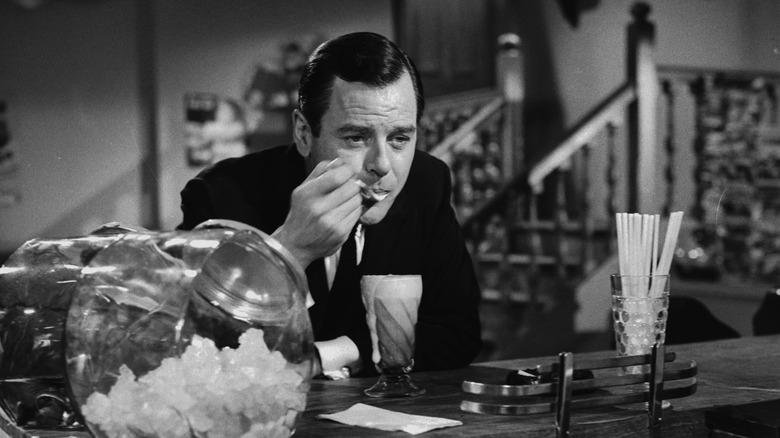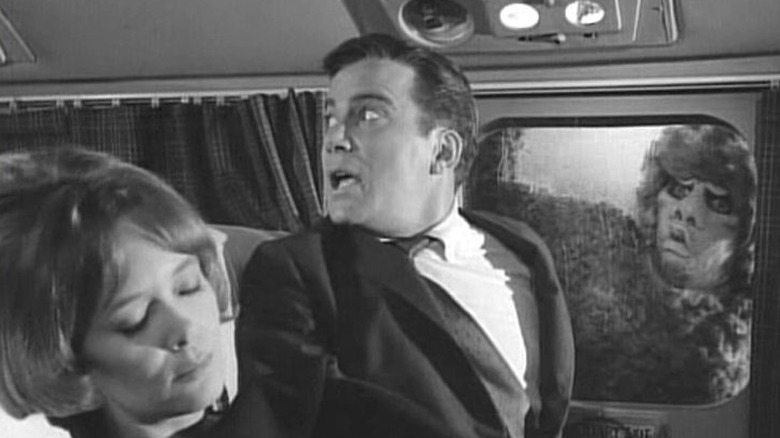5 Essential Twilight Zone Episodes That Everyone Should Watch At Least Once
There is perhaps no TV show from the classic era that has stood the test of time better than "The Twilight Zone." Despite its black-and-white coloring, limited budgets, and retro sci-fi stylings, the Rod Serling series remains one of the greatest, most influential shows ever put to American television. Though there have been many attempts to reboot the series, none of which have been as successful as less direct successors like "Black Mirror," the original series from the late 1950s and early '60s remains the best one to watch. Thankfully, its greatest episodes also hold up incredibly well.
Picking just five "Twilight Zone" episodes to recommend is a challenging task, as all five seasons are loaded with classics. Commentaries on war, death, greed, adventures in space exploration, a surprising number of Western-themed "Twilight Zone" episodes, monsters, ghouls, ghosts, deals with the devil, red Scare metaphors — it's all there and well worth watching. But for our purposes here, we'll be looking at five of the most famous, foundational, and spectacular entries in the anthology series, with the goal of giving newcomers a place to start.
To that end, we will do our best to avoid spoilers here. If you want to go in knowing absolutely nothing, I suggest just noting the episode names and numbers, but this is meant as a teaser. If you need more convincing, read on and discover five "Twilight Zone" episodes bound to get you hooked.
Time Enough at Last (season 1, episode 8)
The first entry on our list is, appropriately, one of the earliest episodes of "The Twilight Zone" to air. Eight episodes into the show's first season, TV viewers were treated to the absolutely unforgettable "Time Enough at Last," a meditation on the nuclear doomsday fears of the era and the grim reality of true loneliness.
Stage and screen legend Burgess Meredith plays mild-mannered bank teller Henry Bemis, an avid reader who takes his lunch breaks within the solitude of the bank's vault. There, he can enjoy the peace and quiet of his books, undisturbed. The curious break spot also ends up protecting him when nuclear war arrives, making him the sole survivor of his town. Despite the unfathomable destruction, Bemis sees a silver lining to the end of the world — more opportunities for him to enjoy his favorite hobby, undisturbed by other humans. Of course, that grand plan isn't quite as happy or fool-proof as it may sound.
This is basically a classic monkey paw story — a "be careful what you wish for" parable with some fun sci-fi trimmings. That genre became one of the show's staples in the years after "Time Enough at Last" first aired, and it remains perhaps the finest such example in the entirety of "The Twilight Zone."
The Monsters are Due on Maple Street (season 1, episode 22)
The Red Scare is a frequent source of inspiration in "The Twilight Zone," which often puts a sci-fi spin on the very real political paranoia and xenophobia gripping the U.S. in the years around the show. There are several great examples of episodes that explore these ideas, and I almost put a different one here — namely, the stranded-strangers drama "Will the Real Martian Please Stand Up?" That gets an honorable mention all the same and is well worth the watch, but for a list of the most foundation episodes, we're going with "The Monsters are Due on Maple Street."
Featuring the likes of Claude Akins and Burt Metcalfe, this episode follows the residents of a small American town who grow increasingly wary of one another after what appears to be a meteor crash and an accompanying power outage. When some start to make accusations of an alien invasion, neighbors quickly begin turning on one another.
This is an episode less about some final twist and more about the infectious nature of paranoia. It's regularly held up as one of the show's most exemplary episodes, and for good reason.
Five Characters in Search of an Exit (season 3, episode 14)
Most "Twilight Zone" episodes put a twist on a real historic or imagined futuristic situation — magic passing through an old Western town, for instance, or a World War II pilot accidentally traveling through time. "Five Characters in Search of an Exit," by contrast, is one of the show's most abstract episodes, with very little grounding in our own world to explain the strange setup.
The story goes exactly how you'd guess from the title: Five characters — a "clown, hobo, ballet dancer, bagpiper, and an army major," as named in Serling's opening narration — awaken in at the bottom of a metal pit with no memories of how they got there. Together, and with a growing sense of panic, they try to divine a means of escape, all the while struggling to identify the nature of their situation.
This is the kind of episode that shows just how much energy you can pull from a few costumes and a basic set. It's captivating in its abstraction, showing the full breadth of the kinds of stories possible in "The Twilight Zone."
Walking Distance (season 1, episode 5)
While not always the case, "The Twilight Zone" often deals in more violent ideas, with war, death, betrayal, paranoia, and other high-stakes themes playing core roles on many episodes. "Walking Distance," another very early episode of the show, may seem tame by comparison, but it's important to highlight the more subtle and sublime episodes.
The setup here is simple. After taking his car to a service station in the middle of a long drive, advertising executive Martin Sloan (Gig Young) realizes that he's walking distance from the small town where he grew up, and he decides to make a visit while the mechanic is working on his car. Once there, though, Martin discovers that he has passed back through time to the days of his childhood.
The episode explores themes of nostalgia and obsession with the past, and it has one of the most underrated endings to a "Twilight Zone" episode. But we'll let you find that one out for yourself.
Nightmare at 20,000 Feet (season 5, episode 3)
Closing out our list is perhaps the most famous episode of "The Twilight Zone," and not just because it stars William Shatner (though that's certainly a big part of the episode's legacy). A highlight of the original series' final season, "Nightmare at 20,000 Feet" follows Robert Wilson (Shatner) on a flight home that takes a frightening turn.
While looking out the window of the plane in the air, Robert sees a monster of some sort clambering over the wing. But when he tries to get a flight attendant's attention, the creature disappears. So begins an escalating episode of terror, which is complicated by the knowledge that Robert was recently institutionalized after a psychotic breakdown.
This reflects the creepier side of "The Twilight Zone," and it remains one of the show's best stories, even if it's been done to death a bit over the past several decades.
